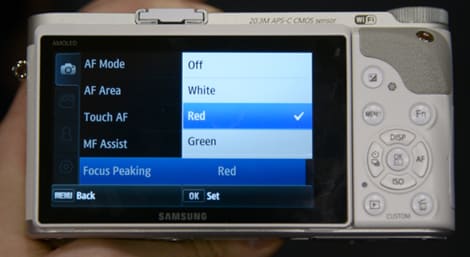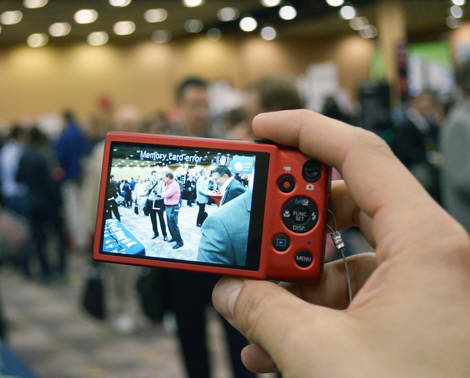Pros
Cons
Introduction
Design & Appearance
{{section_header}}{{section.name}}{{/section_header}}
The Samsung NX210 is a compact system camera that is nearly identical in size and weight to Samsung's entry-level NX1000. The main difference between the two has to to with material. The NX210 has a more durable metal shell, while the NX1000 is encased in smooth, hard plastic. Surprisingly, the NX210's metal body doesn't add any more weight compared to the NX1000, but it does give the camcorder a slightly different appearance.
Tour
{{section_header}}{{section.name}}{{/section_header}}




Menu
{{section_header}}{{section.name}}{{/section_header}}
Samsung added some new menu features to the NX210, but it's the same new Smart Panel quick menu that is found on the NX1000 and NX20 cameras. The NX210 is also compatible with i-Function lenses, which gives you an extra method for controlling features like aperture, shutter speed, white balance, and even some image effects.
Ease of Use
{{section_header}}{{section.name}}{{/section_header}}
Samsung calls the NX210 the "versatile and powerful" choice among the new NX cameras it launched this week. This basically means it's positioned right between the "approachable" NX1000 and the "pro-grade" NX20. In the end, the NX210 isn't much different than the NX1000—it's got nearly identical proportions and most of the same features—so it isn't really any different to use. The NX20 comes with a big larger of a lens, so that could make it more challenging to handle for some users, and it comes with an AMOLED LCD instead of a TFT-LCD that is featured on the NX1000.


Size & Handling
{{section_header}}{{section.name}}{{/section_header}}
According to Samsung's specs, the NX210 has the same dimensions (4.59 x 2.46 x 1.44 inches) and the same wight (just about half a pound) as the NX1000 camera. Of course, the NX210 comes with a slightly larger lens (18-5mm kit lens), so that will make it a big heftier as a whole package.
The NX210 handles much like most compact system cameras we work with. It can feel great with a small lens, and it can easily be used in one-handed, but it may feel strange to people who are used to larger SLR cameras with bulky grips. The right-side bump on the NX210 is subtle, and it doesn't give your fingers much to wrap around in order to grip the camera.


Modes Overview
{{section_header}}{{section.name}}{{/section_header}}
The mode dial on the top of the NX210 features some familiar settings like Program, Aperture Priority (A), Shutter Priority (S), Manual, Scene, Movie, and Smart Auto. But there's also a few special modes like Samsung's Lens Priority mode and a WiFi mode that makes use of the camera's built-in wireless functions.

Auto Mode
{{section_header}}{{section.name}}{{/section_header}}
Samsung's auto mode is called Smart Auto, which is a term Samsung uses on a wide range of appliances (their TVs are Smart, as are some cellphones and tablets). The auto mode works similarly to most modern auto modes, in that it attempts to predict what the correct shooting settings should be based on a variety of elements (like light, focal length, etc.). The mode works well a lot of the time, but it's not perfect—just like any dedicated auto mode. We found it utilized a very quick autofocus mechanism in this setting, but exposure levels weren't always consistent (strong backlight gave this mode trouble at times).

Movie Mode
{{section_header}}{{section.name}}{{/section_header}}
All three of Samsung's new NX cams—the NX1000, NX20, and NX210—can record Full HD 1080p video using a 30p frame rate. The cameras are also equipped with a unique 24p cinema setting that reduces the aspect to a very wide view at a 1920 x 810 resolution. We haven't seen a setting like this before on a consumer camcorder, so it's fairly interesting to see here. You can also shoot video at lower-quality settings (720p, VGA, and a very 320 x 240 mode that's good for sharing on the web).
Drive/Burst Mode
{{section_header}}{{section.name}}{{/section_header}}
Samsung touts the NX210's 8fps continuous shooting mode (at full resolution!) as one of the camera's strongest features. The setting definitely looks good on paper, and we managed some impressive results with that rate, but we also noticed the camera required a lot of processing after each photo burst. It wasn't always bad, but a few times the camera needed to pause for about 4-5 seconds after we took a burst of shots.
Playback Mode
Picture Quality & Size Options
{{section_header}}{{section.name}}{{/section_header}}
The camera tops out with a 20-megapixel still image size option, which is very impressive for a camera of this size. In addition to this large option, the NX210 can capture 10.1-megapixel 3:2 images, 7.8-megapixel 16;9 images, and 13.3-megapixel 1:1 images (and many more lower-resolution sizes). There are also three quality settings on the camera—Super Fine, Fine, and Normal—and the camera can shoot in both RAW (20 megapixels) and JPEG.
Other Modes
{{section_header}}{{section.name}}{{/section_header}}
Built-in Wifi
One of the biggest additions to the NX210, and one of the few features that sets it apart from the NX200, is the addition of a built-in WiFi function. The WiFi feature lets you do a lot of stuff, so you shouldn't just think of it as a nifty way to copy photos from your camera to a computer without using cables. It allows for auto backup, sharing of photos with a Smart TV, and it can even enable you to use your smartphone as a remote viewfinder. We didn't get to see all of these WiFi features in action, but we got a few demos, and, we must admit, some of the features we saw were very interesting.
We were particularly fond of the remote viewfinder function, although we have doubts that this feature—or any of the WiFi functions—is going to work smoothly for everyone all the time. Nearly every WiFi-enabled product we've worked with in the past has given us some issues at some point, so we're excited about getting these Samsung cameras into our labs in order to test the effectiveness of the WiFi.
Focus
{{section_header}}{{section.name}}{{/section_header}}
Focus can be set manually on the NX210, but controlling the focus depends on the lens you're using. There are some manual focus assist functions built into the camera (like a focus zoom) that can help when you set focus, however. There's also two types of autofocus, one being a continual autofocus and the other being the more traditional single-shot AF. The continual autofocus can be slow at times, but it is accurate and it even works during video recordings. It's also one of the premier benefits of using a mirrorless camera as opposed to a traditional DSLR.
Exposure & Metering
{{section_header}}{{section.name}}{{/section_header}}
Both shutter speed and basic exposure adjustments can be made on the NX210, and the camera's fastest shutter option is 1/4000 of a second. If you want more than that, you must jump to the NX20, which goes up to 1/8000 of a second. Slow shutter speeds are featured on the NX210 as well, going down to 30 seconds and a bulb mode that can last for up to four minutes.
ISO
{{section_header}}{{section.name}}{{/section_header}}
Featuring an ISO range from ISO 100 to ISO12800, the Samsung NX210 shows a reasonable range for a compact system camera. You can also switch over to auto ISO, which allows you to set an upper limit to the ISO the camera will choose automatically (ISO 3200 is the max upper limit in this mode).
White Balance
{{section_header}}{{section.name}}{{/section_header}}
If you don't want to set white balance manually or select a specific Kelvin color temperature, you can probably get by with the NX210's auto white balance setting. It worked well in bright, outdoor light during our time with the camera, but we can't say how well it will do under mixed indoor lighting. There are also a number of white balance presets on the NX210: Daylight, Cloudy, Fluorescent (three different types), Tungsten, and Flash.
Picture Effects
{{section_header}}{{section.name}}{{/section_header}}
There are two different set of picture effects on the NX210. The first comes in the form of Samsung's Picture Wizard modes that include preset color options like standard, vivid, portrait, landscape, forest, retro, calm, cool, classic, and custom. In Picture Wizard you can also make slight adjustments to contrast, sharpness, saturation, and color. It's basically like having a small palette of photoshop tools at your disposal (before you take your shot). There's also a selection of smart filters that are similar to the picture wizard mode, but are more like digital effects that manipulate your video or stills.
Conclusion
The NX210 isn't a revolutionary camera by any means. It has the same 20.3-megapixel CMOS sensor as its predecessor, the NX200, and the only huge new addition is the inclusion of a Samsung's built-in WiFi feature. By this rationale, the NX210 is "smarter" than its predecessor, as that's the adjective Samsung uses to describe its products with WiFi technology. The NX210 can not only transfer photos wirelessly from camera to computer, but it can also use its WiFi function to connect to smartphones and Samsung Smart TVs. This allows for some really cool options, like using your smartphone as a remote viewfinder for the camera, for example.
The NX210's $899 price tag is no different than the launch price of the previous NX200, so it's not like Samsung is asking for more money this time around. It's just a simple update to a compact system camera that did a decent job when we tested it last December.
{{product.vanity}}
Sample Photos
{{section_header}}{{section.name}}{{/section_header}}
Specs
{{manufacturer_specs_table}}
Meet the tester
Jeremy is the video expert of our imaging team and Reviewed.com's head of video production. Originally from Pennsylvania and upstate NY, he graduated from Bard college with a degree in film and electronic media. He has been living and working in New England since 2005.
Checking our work.
Our team is here to help you buy the best stuff and love what you own. Our writers, editors, and experts obsess over the products we cover to make sure you're confident and satisfied. Have a different opinion about something we recommend? Email us and we'll compare notes.
Shoot us an email